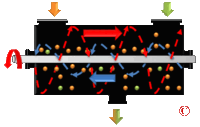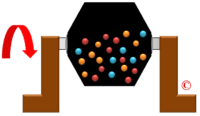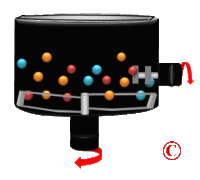Industrial mixer








Industrial mixers and blenders are used to mix or blend a wide range of materials used in different industries including the food, chemical, pharmaceutical, plastic and mineral industries. They are mainly used to mix different materials using different types of blades to make a good quality homogeneous mixture. Included are dry blending devices, paste mixing designs for high viscosity products and high shear models for emulsification, particle size reduction and homogenization. Industrial mixers range from laboratory to production line scale.
They can operate at different temperatures and pressures for mixing different solutions and can also have internal or external heating systems added to them. Options also exist where spray nozzles, CIP, PLC and pneumatic or electric systems can be used. Systems can come equipped with hydraulic or electronic soft start mechanisms so that they start and stop smoothly.
In addition to performing typical batch mixing operations, some mixing can be done continuously. Using a machine like the Continuous Processor, one or more dry ingredients and one or more liquid ingredients can be accurately and consistently metered into the machine and see a continuous, homogeneous mixture come out the discharge of the machine.[1] Many industries have converted to continuous mixing for many reasons. Some of those are ease of cleaning, lower energy consumption, smaller footprint, versatility, control, and many others. Continuous mixers, such as the twin-screw Continuous Processor, also have the ability to handle very high viscosities.
Basic Nomenclature
For liquid mixing, the nomenclature is rather standardized:
- Impeller Diameter, "D" is measured for industrial mixers as the maximum diameter swept around the axis of rotation.
- Rotational Speed, "N" is usually measured in revolutions per minute(RPM) or revolutions per second(RPS). This variable refers to the rotational speed of the impeller as this number can differ along points of the drive train.
- Tank Diameter, "T" The inside diameter of a cylindrical vessel. Most mixing vessels receiving industrial mixers will be cylindrical.
- Power, "P" Is the energy input into a system usually by an electric motor or a pneumatic motor
- Impeller Pumping Capacity, "Q" The resulting fluid motion from impeller rotation.
Mixing Calculations
The level of mixing is determined by the pumping effect or dynamic response that the mixer imparts into the fluid. When a mixing impeller rotates in the fluid, it generates a combination of flow and shear. The impeller generated flow can be calculated by using the following equation:
- Flow (GPM) = (power number * RPM * Impeller_Diameter^3) / 231
To calculate power draw, use the following equation:
- Power (HP) = (Power_Number * RPM^3 * Impeller_Diameter^5 * Fluid_Specific_Gravity) / (1.525 * 10^13)
Types of Mixers
- Ribbon Blender
- V Blender
- Continuous Processor
- Cone Screw Blender
- Screw Blender
- Double Cone Blender
- Double Planetary
- High Viscosity Mixer
- Counter-rotating
- Double & Triple Shaft
- Vacuum Mixer
- High Shear Rotor Stator
- Dispersion Mixers
- Paddle
- Jet Mixer
- Mobile Mixers
- Drum Blenders
- Intermix mixer
- Horizontal Mixer
- Hot/Cold mixing combination
- Vertical mixer
- Turbomixer
- Planetary mixer
- A planetary mixer is a device used to mix round products including adhesives, pharmaceuticals, foods (including dough), chemicals, electronics, plastics and pigments.
- This mixer is ideal for mixing and kneading viscous pastes (up to 6 million centipoise) under atmospheric or vacuum conditions. Capacities range from 0.5 US pints (0.24 l; 0.42 imp pt) through 750 US gallons (2,800 l; 620 imp gal). Many options including jacketing for heating or cooling, vacuum or pressure, vari speed drives, etc. are available.
- The blades each rotate on their own axes, and at the same time on a common axis, thereby providing complete mixing in a very short timeframe.
- Banbury mixer
- The Banbury mixer is a brand of internal batch mixer, named for inventor Fernley H. Banbury. The "Banbury" trademark is owned by Farrel Corporation. Internal batch mixers such as the Banbury mixer are used for mixing or compounding rubber and plastics. The original design dates back to 1916.[2] The mixer consists of two rotating spiral-shaped blades encased in segments of cylindrical housings. These intersect so as to leave a ridge between the blades. The blades may be cored for circulation of heating or cooling. Its invention resulted in major labor and capital savings in the tire industry, doing away with the initial step of roller-milling rubber.[3] It is also used for reinforcing fillers in a resin system.